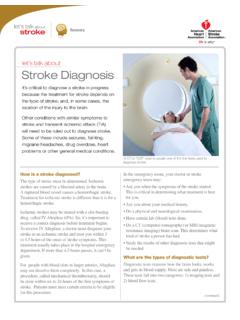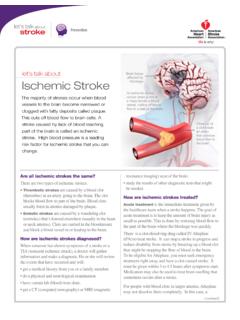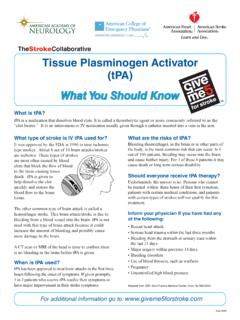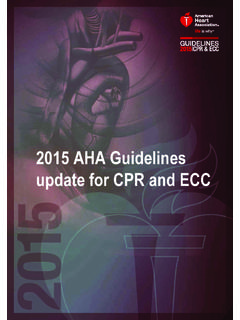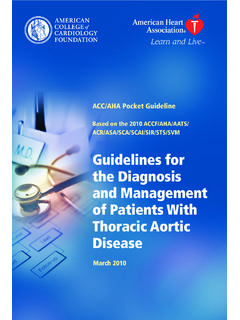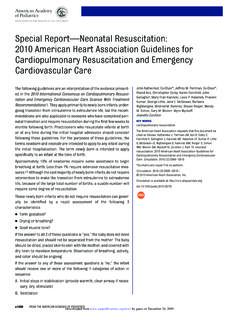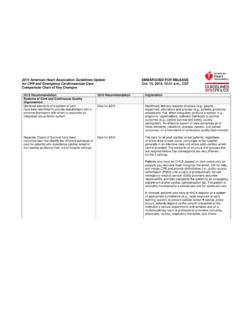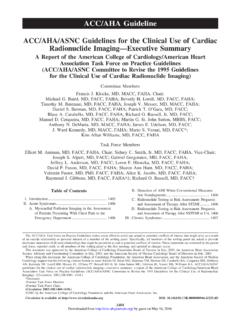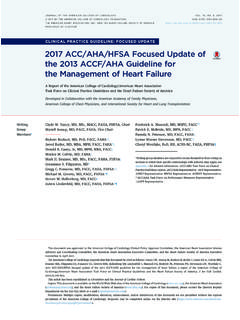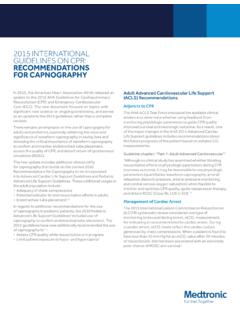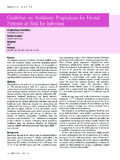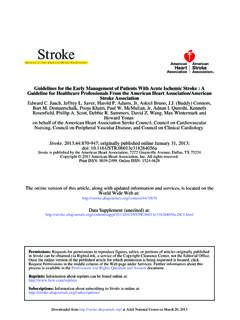Transcription of GUIDELINES FOR THE EARLY MANAGEMENT ... - Stroke …
1 A Summary for Healthcare Professionals from the american Heart association / american Stroke association 2018 american Heart Association2018 UPDATEQUICK SHEETGUIDELINES FOR THEEARLY MANAGEMENT OF PATIENTS WITH ACUTE ISCHEMIC Stroke REFERENCES: 1. 2018 GUIDELINES for the EARLY MANAGEMENT of Patients With Acute Ischemic Stroke : A Guideline for Healthcare Professionals From the american Heart association / american Stroke association . 2. Modi_ed from Kothari RU, Pancioli A, Liu T, Brott T, Broderick J. Cincinnati Prehospital Stroke Scale: reproducibility and validity. Ann Emerg Med. 1999;33:373-378. With permission from Elsevier. @private/@wcm/@ 3. Summer D, Leonard A, Wentworth D, et al. Comprehensive Overview of Nursing and Interdisciplinary Care of the Acute Ischemic Stroke Patient.
2 Stroke 2009;40;2911-2944. The path to achieve these goals is represented in the flow chart on the next IV r-tPA within hours of Stroke onset remains the standard of care for most ischemic Stroke patients, providing the opportunity for more favorable outcomes. Patients eligible for IV alteplase should receive it, even if mechanical thrombectomy is being considered. Mechanical thrombectomy using stent retrievers within up to 24 hours of Stroke onset may lead to faster and more complete reperfusion for certain selected patients with AIS within 6-16 hours of last known normal who have large vessel occlusion in the anterior circulation and have favorable imaging studies, mechanical thrombectomy is benefits of both IV alteplase and mechanical thrombectomy are time dependent.
3 The earlier the treatment within the time window, the greater the benefit to patients. The 2018 comprehensive guideline updates guidance on which patients are eligible to receive IV alteplase, mechanical thrombectomy and other Stroke treatments to reduce long-term brain imaging studies be performed within 20 minutes of arrival in the ED for patients who may be candidates for IV alteplase and/or mechanical from symptom onset to intravenous alteplase IV r-tPA should be less than 3 hours and never more than from first Stroke symptom to mechanical thrombectomy should be as quickly as possible within up to 24 hours in selected achieve expedited care, public awareness of the signs of Stroke and importance of calling 9-1-1 immediately by the community is Regional systems of EARLY Stroke care should be developed that coordinate first-contact services with local and regional hospitals to achieve minimum delay time from symptom onset to definitive treatment.
4 KEY TAKEAWAYS:OUT OF HOSPITALASSESS FOR Stroke (I)(FAST, CPSS, LAPSS)POSITIVERECOGNITION(by bystander)FIRST MEDICAL CONTACT (II)IN EMERGENCYDEPARTMENTNIHSS (III)IMMEDIATEDIAGNOSTICS(evaluating patients for alteplase IV r-tPA)ALL PATIENTS (IV)SELECT PATIENTS (V)EVALUATE FORALTEPLASE IV r-tPASIMULTANEOUSEVALUATE FORMECHANICAL THROMBECTOMY (VIII)<24 HOURSIN SELECT PATIENTS 3 HOURS (VI)QUALIFIESADMINISTERMECHANICALTHROMBECTOMY (X)QUALIFIESADMINISTER ALTEPLASE IV r-tPA (IX)QUALIFIESEARLY ACUTEISCHEMICSTROKE CAREMANAGEMENTFLOW CHART3 HOURS (VII)EMS Team to identify if there is evidence of an Acute Ischemic COPY FOR NUMBERED SECTIONS OF THE FLOW CHART:*also note time of day hour and minuteF A S TFACEDROOPINGSPEECHDIFFICULTYTIME TOCALL 911*ARMWEAKNESSIIIF irst Medical Contact (EMS Provider )1 Assess and manage ABCs (airway, breathing, circulation)Check and monitor blood pressure, but do not treatInitiate cardiac monitoring Provide supplemental oxygen to maintain O2 saturation > 94%Establish IV access Determine blood glucose and treat accordingly Determine time of symptom onset or last known normal, and obtain family contact information, preferably a cell phone Triage and rapidly transport patient to nearest most appropriate Stroke hospital Notify hospital of pending Stroke patient arrivalSeverity Stroke scales/assessment of large vessel occlusion (RACE, LAMS or CPSSS)
5 IVVIIIA ssess for Stroke using a validated screening tool, such as , Cincinnati Prehospital Stroke Scale, or Los Angeles Prehospital Stroke Screen3 NIHSS in Emergency DepartmentImmediate Diagnostics All Patients1 Noncontrast brain CT or brain MRI (within 20 minutes of ED arrival)Blood glucose levelOxygen saturationSerum electrolytes/renal function tests CBC, including platelet testing Markers of cardiac ischemia Prothrombin time (PT)/INR Activated partial thromboplastin time (aPTT)ECGI mmediate Diagnostics Select Patients1 Thrombin time (TT) and/or ecarin clotting time (ECT) if it is suspected the patient is taking direct thrombin inhibitors or direct factor Xa inhibitorsHepatic function tests Toxicology screen Blood alcohol level Pregnancy test Arterial blood gas tests if hypoxia is suspected Chest radiography if lung disease is suspected Lumbar puncture if subarachnoid hemorrhage is suspected and CT scan is negative for blood Electroencephalogram if seizures are suspected CT-A (angiogram) and/or CT-P (perfusion)TEXT COPY FOR NUMBERED SECTIONS OF THE FLOW CHART CONTINUED:VIBlood glucose concentration <50 mg/dL ( mmol/L) CT demonstrates multilobar infarction (hypodensity >1/3 cerebral hemisphere)Relative exclusion criteria.
6 Recent experience suggests that under some circumstances with careful consideration and weighting of risk to bene t patients may receive brinolytic therapy despite one or more relative contraindications. Consider risk to bene t of alteplase IV r-tPA administration carefully if any of these relative contraindications are present:Only minor or rapidly improving Stroke symptoms (clearing spontaneously)PregnancySeizure at onset with postictal residual neurological impairmentsMajor surgery or serious trauma within previous 14 daysRecent gastrointestinal or urinary tract hemorrhage (within previous 21 days)Recent acute myocardial infarction (within previous 3 months)Evaluate for IV r-tPA ( 3 hours)1 Inclusion criteria:Diagnosis of ischemic Stroke causing measurable neurological de cit Onset of symptoms <3 hours before beginning treatment Aged 18 years Exclusion criteria.
7 Signi cant head trauma or prior Stroke in previous 3 months Symptoms suggest subarachnoid hemorrhage Arterial puncture at noncompressible site in previous 7 days History of previous intracranial hemorrhage Intracranial neoplasm, arteriovenous malformation, or aneurysm Recent intracranial or intraspinal surgery Elevated BP (systolic >185 mm Hg or diastolic >110 mm Hg) Active internal bleeding Acute bleeding diathesis, including but not limited to:Platelet count <100,000/mm3 Heparin received within 48 hours, resulting in abnormally elevated aPTT greater than the upper limit of normalCurrent use of anticoagulant with INR > or PT >15 secondsCurrent use of direct thrombin inhibitors or direct factor Xa inhibitors with elevated sensitive laboratory tests (such as a PTT, INR, platelet count, and ECT, TT, or appropriate factor Xa activity assays)TEXT COPY FOR NUMBERED SECTIONS OF THE FLOW CHART CONTINUED:XVIIIVIIIXA dmit the patient to an intensive care or Stroke unit for monitoring for at least 24 hours.
8 If the patient develops severe headache, acute hypertension, nausea, or vomiting or has a worsening neurological examination, discontinue the infusion (if alteplase IV r-tPA is being administered) and obtain emergent CT scan. Measure BP and perform neurological assessments every 15 min during and after alteplase IV r-tPA infusion for 2 hours, then every 30 min for 6 hours, then every hour until 24 hours after alteplase IV r-tPA treatment. Increase the frequency of BP measurements if systolic BP is >180 mm Hg or if diastolic BP is >105 mm Hg. Administer antihypertensive medications to maintain blood pressure at or below these levels. Delay placement of nasogastric tubes, indwelling bladder catheters, or intra-arterial pressure catheters if the patient can be safely managed without them.
9 Obtain a follow-up CT or MRI scan at 24 hours after alteplase IV r-tPA before starting anticoagulants or antiplatelet Mechanical Thrombectomy1In select patients with AIS within 6-16 hours of last known normal who have large vessel occlusion in the anterior circulation and have favorable imaging studies, mechanical thrombectomy is studies may indicate some patients could reasonably have mechanical thrombectomy up to 24 hours after last known patients who undergo mechanical thrombectomy, it is reasonable to maintain blood pressure 180/105 during and for 24 hours after the for alteplase IV r-tPA (3 hours)1 Inclusion criteria:Diagnosis of ischemic Stroke causing measurable neurological de citOnset of symptoms within 3 to hours before beginning treatmentTreatment risks should be weighed against possible bene tsRelative exclusion criteria: Aged >80 yearsSevere Stroke (NIHSS>25)Taking an oral anticoagulant regardless of INRH istory of both diabetes and prior ischemic strokeEvaluate for Mechanical Thrombectomy (< 24 hours)1 Evaluation for alteplase IV r-tPA and evaluation for mechanical thrombectomy happens simultaneously Within 6 hours.
10 Prestroke mRS score 0 1 Acute ischemic Stroke receiving intravenous alteplase IV r-tPA within hours of onset Causative occlusion of the ICA or proximal MCA (M1) Age 18 years NIHSS score of 6 ASPECTS of 6 For those selected patients in whom mechanical thrombectomy initiated within 6-24 hours have LVO in anterior circulation and meet other eligibility criterias recommended. Administer alteplase IV r-tPA1 Infuse mg/kg (maximum dose 90 mg) over 60 minutes, with 10% of the dose given as a bolus over 1 minute. More information 2018 american Heart Associatio





